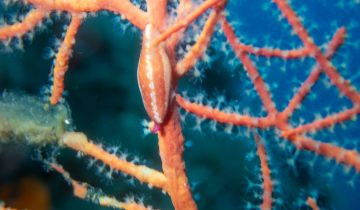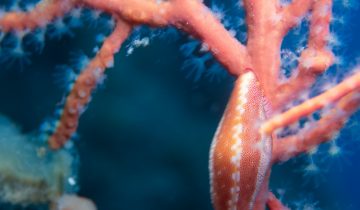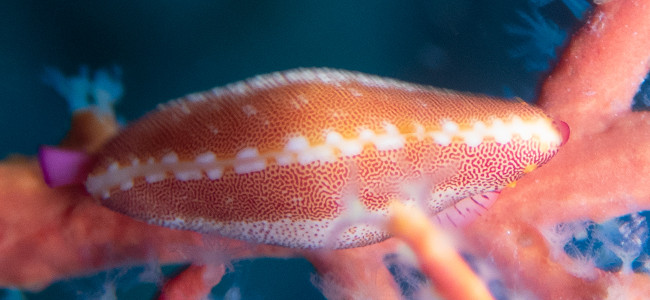Simnia spelta, commonly known as the False Cowrie, is a small sea snail species belonging to the phylum Mollusca, class Gastropoda, order Littorinimorpha, and family Ovulidae. It was first described in 1758 by Carl Linnaeus. The specific epithet ‘spelta‘ refers to spelt grain, due to the resemblance of its shell to this cereal. This species lives on gorgonians of the genera Eunicella, Paramuricea, and Leptogorgia, at depths ranging from 2 to 60 meters. Although once considered endemic to the western Mediterranean and Adriatic Sea, it is now known to also occur in the eastern Atlantic, from northern Iberian Peninsula down to Angola, including the Canary Islands and Azores.
The shell of Simnia spelta reaches a length between 15 and 20 mm, with an elongated, fusiform, and ovate shape, smooth, thick, shiny surface, and lacking an operculum. The spire is hidden, enclosed by the last whorl. The aperture is elongated with rolled edges and no denticles, giving it a clean and polished appearance. Its coloration is very variable and depends on the type of gorgonians it inhabits, ranging from white, yellow, pink to orange, often with spots or streaks. The mantle of the animal covers the shell while active, mimicking the host’s color, providing very effective camouflage. It can be easily confused with Simnia aperta, which has a more robust shell and brown coloration, or with Simnia nicaeensis, which has a mantle with conical tubercles and a thinner, more fragile shell. It may also resemble Pseudosimnia carnea, which is exclusively associated with red coral.
Simnia spelta is a specialized predator feeding on gorgonians, specifically the polyps and connective tissue (coenenchyme) of species such as Eunicella singularis, Paramuricea clavata, and Leptogorgia sarmentosa. Using its radula, it carefully scrapes the tissue without killing its host, maintaining a long-lasting relationship. The pigment from these gorgonians accumulates in its mantle, which is why its coloration blends perfectly with the environment. After feeding, the gorgonians branches are left bare, facilitating subsequent colonization by epibionts.
The sexes in Simnia spelta are separate, and fertilization is internal. Copulation occurs with the female positioned over the male. The reproductive period lasts from May to September. Egg laying consists of tiny translucent gelatinous capsules attached around the gorgonians branches. Each capsule contains multiple white eggs, and their appearance resembles the natural irregularities of the branches, providing additional camouflage. The eggs hatch into planktonic larvae that later settle on new gorgonians.
An interesting fact about Simnia spelta is that the characteristic shine of its shell is not inherent to the shell itself but is maintained by the mantle that covers it externally. If disturbed or threatened, the animal retracts its mantle and the shine temporarily disappears. Its close relationship with gorgonians represents a form of interaction close to commensalism, though technically it is mild parasitism, as it feeds on the host without killing it. Furthermore, the extreme mimicry it exhibits with its gorgonians host is an excellent example of evolutionary adaptation to avoid predators.
Photos:


